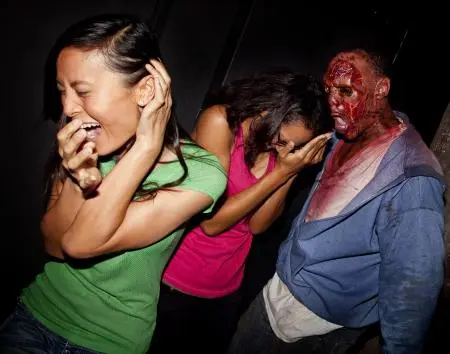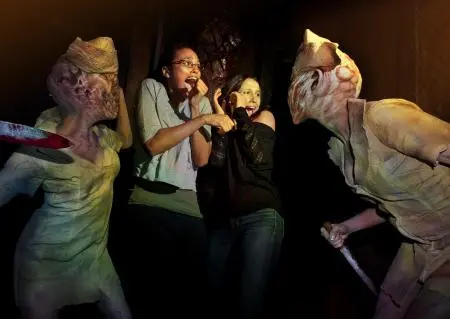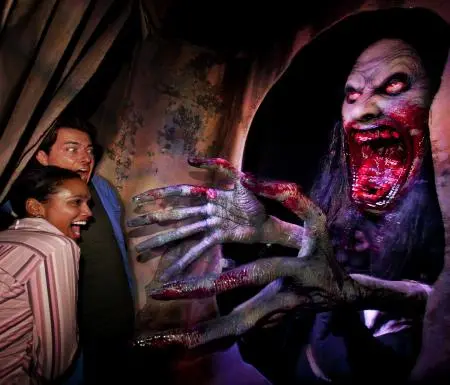LURID: vivid in shocking detail; sensational, horrible in savagery or violence, or, a guide to the merits of the kind of Bad Books you never want your co-workers to know you're reading.
Horror, as I said in my first column, should evoke a physical rather than a simply cerebral reaction. Racing heart, twisting guts, shaking hands; that’s why we relish the genre so. That’s why we eagerly devour books, video games and movies that put us up close and personal with zombies, vampires, creatures from the deep, supernatural child-snatchers, vengeful hunchbacks, phantom hotel guests, killer clowns et al. We love it when these monsters loom up from our imaginations and hiss in our ears, trailing their raptor claws across our quivering cheeks. It’s a thrill thing, a safe way to get some much-needed kicks.
But books, videogames and movies are merely media, intervening agencies that deliver secondary scares. Head trips, as opposed to the real deal. After a while, our senses become dulled to their tricks. Therefore October, named for the number 8, the ever-trickling hourglass of life and death, is always a treat for horror fans. For one glorious month there’s a delicious way of upping the thrill dose. All across America, on berry farms, cruise ships, shopping mall parking lots, in disused theatres and existing theme parks, Horror Haunts spring up, like so many psilocybic mushrooms of fun. Haunts pull the monsters from our imaginations and deposit them in the dark corners of mazes. There they lurk, against a backdrop of blood, guts, giant spiders, severed limbs, dessicated cats and trailing tendrils of who-knows-what, ready to leap out at passersby making them scream and scream again.
Haunts deliver a horror story in its rawest form: set-up, kick. The audience enters the zone, absorbs the scenario, receives the shock (the lunging creature, the loud noise, the blast of cold air, the cascade of cobwebs), screams, and moves on. It’s an instant, immersive and visceral experience, exactly what good storytelling should be. Horror writers can learn a lot from the efficiency and speed of the Haunt experience: when it comes to keeping punters scared and happy, those mazes and rides really work.
Themed Haunts are a valuable aspect of a horror franchise. What better way to engage fans than depositing them on a replica of the movie or game set and introducing them to the eyeless nurses or chainsaw-wielding maniacs face-to-face? Let them smell the diesel fumes and coffin liquor, feel the claustrophobia and the sudden drop in temperature, turn the corner and confront the yowling gimp blocking the single available exit. Let them scream and/or piss their pants – it doesn’t get any more personal than this. It’s a guaranteed method of creating all-five-senses memories that will only enhance the experience next time they read the book, watch the movie or play the game.
These days, writers, or anyone involved in pitching and developing intellectual property, need to be fully aware of the transmedia possibilities of their concept. How many ways can you tell your story, in parallel and tangent? Does it work as a book, a movie, a game, an app, a graphic novel or a TV show? Those working within the horror genre would do well to ask ‘Does it work as a Haunt?’ What’s the point of all that intensive world-building and backstory unless you can manifest it in three dimensions?
Universal Studios have been thinking along these lines for a while. They’ve been presenting horror-themed evenings in their parks since 1991, beginning with a three night ‘Fright Night’ event at Universal Studios Florida before expanding into the mammoth month-long Halloween Horror Nights® festival of today. If you’ve been to the event in Florida, Hollywood or Singapore, you’ll know what to expect: sell-out crowds thronging sumptuously designed mazes thick with fantastically made-up “scare-actors” leaping out at every turn. Universal are justifiably proud of their horror branding, which goes all the way back to the classic monsters of the 1930s (Dracula, Frankenstein’s Monster and Bride, The Mummy and The Wolf Man), and see the Horror Nights as a way of celebrating their legacy, as well as promoting newer kids on the block.
The “sickest minds in horror” tasked with designing the Universal haunted attractions face quite a challenge. The capacity crowds, who’ve often been standing in line for a couple of hours, need to be kept moving through the maze in as quick, efficient and safe a manner as possible while still receiving some nasty shocks. The mazes need to be visually differentiated. This is where the strengths of the original story premise come into play. Is the setting instantly recognizable? Is there an iconic character at the heart of the narrative? Is there something intrinsically scary about walking through a door marked with the story’s title i.e. does the audience already have a relationship with and expectations of the brand?
The Walking Dead marque is put to the test in two attractions in the Hollywood location this year. ‘The Walking Dead: Dead Inside’ recreates the desolate suburban and semi-rural locations of the hit AMC TV show. Ordinary people’s homes and outhouses are invaded by brain-sucking zombies, some of them ambulatory (and groaning), some of them frozen in mid-chew, their victims’ innards spilled out across a bland domestic object like a couch or an ironing board. The mundanity of the mise en scène is the most terrifying aspect. It rams home how ill-prepared and helpless we are in the face of any kind of apocalypse, zombie or otherwise. The Walking Dead have also invaded the Universal backlot, where, after a short ride on the Terror Tram, guests are herded through the plane crash site and past the Psycho house, through rows of zombie-containing cages, all the while being ‘directed to safety’ by clueless representatives of the CDC. Both attractions deliver more zombie attacks per minute than happened in the entire first season of the show. It’s disorientating, immersive, and scream-out-loud fun: the concept actually works better in reality than it does on TV.
The Silent Hill franchise gets another movie entry on October 26 (Silent Hill: Revelation), and there’s a maze in honor of that. Silent Hill has always been all about location, location, location, and the haunt draws heavily on the eerie beauty of the fog-bound town, navigable only by flashlight. Iconic scenes from the video games and movie are recreated here, and it’s a shock in itself to walk in on an abandoned school room that looks as though the orphans left just moments ago. The designers have captured the melancholy that soaks every manifestation of Silent Hill, and guests drift through the ash-covered streets experiencing a strange kind of sadness. Of course, it would help to be emotionally invested in each scenario. Maze guests are purposeless. You don’t know who you’re looking for, if anyone. There are no melée weapons to hand. When you finally find your way into the decaying hospital and come face-to-face with those eyeless nurses, it’s frustrating to do nothing but glide past. In this case, the ‘look but don’t touch’ aspect of the haunted attraction is less than satisfying, but the maze still serves as a solid reminder of what to expect with the upcoming movie. Job done.
While there are mazes devoted to Alice Cooper, The Texas Chainsaw Massacre, and the classic Universal Monsters, the most genuinely chilling attraction belongs to La Llorona, the wailing woman who has terrified generations of children across Mexico, Puerto Rico and South America. The facts of her legend are simple; spurned, the beautiful Maria drowned her own children in the vain hope of getting her man back. When she realized the extent of her crime, she killed herself, but was condemned to wander rivers and lakes forever, calling her lost offspring (“Ay, mis hijos!”). Parents warn their own children that if they are naughty, or remain outdoors after nightfall, La Llorona will come for them. This shadowy legend proves just as robust as the slickly fabricated ‘multiverses’ of the other Universal properties as the foundation for a haunted attraction. In fact, as you wander through the rural Mexican village where La Llorona selects her victims into the dank underground chambers where she stashes her mummified trophies, the boogeywoman becomes the most tangible – and frightening – presence of the evening. ‘La Llorona: Cazadora de Ninos’ demonstrates that the oldest, simplest stories are often the most enduring and retain their power to terrify even when translated into a three dimensional form.
The big budget attractions at Universal aren’t the only game in town. Across the USA, an estimated 3,000 Haunts do around $500 million worth of business. They range from the mass entertainment spectacles of the theme parks, churning through thousands of visitors an hour, to the hardcore one-on-one terror of the Blackout Haunted House ("You must walk through alone!") which promises "Complete darkness, crawling, stairs, loud noises, water, physical contact, sexual and violent situations" — and a safe word.
There's also, this year, the dusty intimacy of the Blumhouse of Horrors, situated in the 88 year-old Variety Arts Centre in downtown Los Angeles. The 1,100 seat theatre has been taken over by the producers of the Paranormal Activity movies, Insidious and Sinister and reopened exactly, so their story goes, as it was in 1933, when performer Sadie Butterfield vanished during a magic show. Her centenarian husband, Victor, heckles visitors as they arrive in the lobby – he’s not the most welcoming of hosts – before undertaking a tour up and down and in and out of four floors of this historic building.
En route, they’ll discover Sadie’s disappearance wasn’t the only strange occurrence within the theatre’s walls. There are dueling lovers, a hapless stage magician, carnival freaks, a morose magi and an irate costumier playing out a series of scary vignettes. The art direction is lavish, each set runs a full 360º, and every detail is evocative. Guests walk into real rooms with four walls, and once the door closes behind them, anything can happen. The backstage areas of any theatre can be confusing and disorientating (“Hello Cleveland!”), and are made even more so here by uniformly low light, dry ice and piles of props that sometimes provide a clue to the story in a room and sometimes deliver a nasty shock. It even smells frightening.
Jason Blum says the concept of taking his Blumhouse horror brand live had been knocking round for a couple of years but “what got it moving was the venue…we built out a story from the building and built the scares within the story”. He cites the New York production of Sleep No More, Punchdrunk’s immersive rendition of Macbeth, as an inspiration. It’s easy to see why site-specific theatre would be so appealing to a producer who’s made his name with intense, micro-budget horror films that are all about dropping the audience into a single location and trapping them there. While the Blumhouse of Horrors doesn’t promote a specific title or franchise, it’s an excellent way of testing the proprietary formula on a live audience and encouraging them to roll into a movie theatre to experience the similarly intimate thrills of Sinister (opening today). Says Blum, “I hope that [the audience] are scared. I hope they feel like the scares were organic to a story they were told, but first and foremost I hope they come out frightened in new ways.”
Not every horror story has to become a Haunt. Nonetheless, if you can envisage yours escaping the confines of the page and manifesting as a three-dimensional multi-sensory live scare experience, that might be a sign that you have a robust, transmedia-ready concept worth further development. Ask yourself, if you build it, will fans come?
What are your favorite Haunt escapades? What are the best Haunted Attractions in your area? Which horror property would you like to see re-imagined as a maze? Have you ever worked behind the scenes as a “scare-actor” or designer? Please share your experiences in the comments below.
Blumhouse of Horrors, 940 S. Figueroa St, Los Angeles CA 90017 until November 3rd
blumhouseofhorrors.com
Universal Studios Halloween Horror Nights, Los Angeles and Orlando until October 31
halloweenhorrornights.com

About the author
Karina Wilson is a British writer based in Los Angeles. As a screenwriter and story consultant she tends to specialize in horror movies and romcoms (it's all genre, right?) but has also made her mark on countless, diverse feature films over the past decade, from indies to the A-list. She is currently polishing off her first novel, Exeme, and you can read more about that endeavor here .










